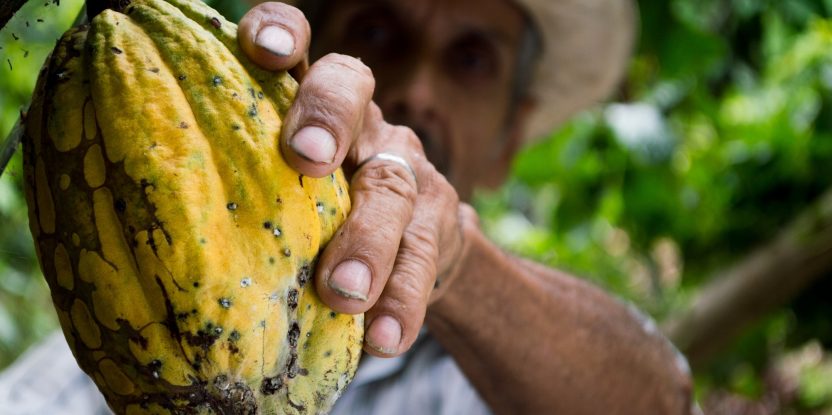In the rainforested northern regions of Peru, cutting-edge climate-smart farming practices are flying under the radar. Multitudes of smallholders in the region grow high-value cocoa and coffee crops under the cover of canopy trees, which provide shade, regulate the climate, build soil fertility, and provide diverse sources of income. The practice, which many locals have practised for generations, yields high-quality beans with much fewer inputs than those required in conventional full-sun plantations.
By maintaining an ecosystem that’s closer to that of a forest, this approach tends to stash more carbon dioxide in its trees, plants, and soil than conventional counterparts, offering an important boon for climate change mitigation. Yet here in Peru, these farmers’ efforts are not integrated into national greenhouse gas (GHG) inventories.
Why? There are several reasons. Most countries use remote sensing as a starting point for tracking and monitoring land use, but it’s not 100 percent effective, and doesn’t work well at all here. “When you have a very dense canopy, and a too-low resolution imagery, it prevents you from differentiating a dense multi strata agroforestry system from forest cover,” said Marta Suber, a scientist at the Center for International Forestry Research and World Agroforestry (CIFOR-ICRAF) who was involved in a new scientific review that lays out some of the key gaps in global research and action on agroforestry for climate mitigation. “Even though this set of management practices is happening across the humid Amazon in a very widespread way, we still lack the means to identify it and then remotely account for the carbon stocked in it.”
Peru is large – about five times the size of the UK – and its Amazonian region is sparsely populated. It also has limited institutional capacity for enforcing measuring and monitoring and reporting of agricultural activities. So, going out into the field to list and monitor farmers one-by-one is not currently feasible – and their management practices even less so. The last national agricultural census is from 2012, so there is no up-to-date picture of the agricultural sector and its practices and trends; even less can be said about how many people are practicing agroforestry – or the impact that’s having on biodiversity and climate mitigation. Despite this, agroforestry’s potential to climate change is at the core of three mitigation measures within Peru’s Nationally Determined Contributions (NDCs) to the Paris Agreement on Climate Change, showing political recognition of its relevance and the intention to support more farmers to embrace the approach.
The country’s situation is not uncommon. Globally, agroforestry has massive mitigation potential – up to 0.3 petagrams of carbon per year, which makes it the largest agricultural natural climate solution opportunity. But the recent review, led by global environmental non-profit The Nature Conservancy (TNC), found that a large amount of research and monitoring is required to integrate it effectively into the planet’s agricultural systems and make the most of its promise.
As the co-authors emphasize, agroforestry’s strength lies in its multifunctionality, diversity, and flexibility, which means systems can be adapted to fit local landscapes and interests – but this also has its challenges. A multitude of agroforestry practices exist, and more knowledge is needed about the carbon mitigation potential of each of them, whilst progress needs to be more effectively tracked. The review found that there is a lack of knowledge about where agroforestry occurs, and that there is uneven uptake and interest in the approach around the world, with farmers in the Global North least interested, on average, in integrating these practices.
To fill some of these knowledge and implementation gaps, said Suber, “there is not just one line of action: there are plenty of them. And they have to happen at the same time, in coordination.” She cited the need for a programmatic approach, where national entities and institutions support regional and local institutions to carry out research and monitoring, assess and lift barriers, and work on enabling conditions to help farmers adopt agroforestry effectively.
“One of the major gaps we face here in Peru, for example, is that there is limited technical assistance on how to manage an agroforestry system, and what is there still relies on technical packages not adapted to the context of implementation,” said Suber. “People combine crops with tree species driven by immediate needs and not necessarily in line with long-term planning. Also, there is scarce knowledge on crop-trees associations and the management required to guarantee high-quality products and productivity, nor what this entails for a continuum of management to set up an operation that’s going to be profitable in the longer term.”
Integrating and tracking agroforestry effectively will require long-term investment from donors and funders, said Suber. “It’s all very well to have breakthroughs every few years on different topics and moving the target towards more complex issues, but you cannot just consider that what you leave behind will automatically be taken care of by others,” she said.
Implementing countries need the resources and capacities to work across all governance levels on agroforestry MRV, with the participation of all types of actors. “You need to make sure that farmers are not dependent on project funding or the technical advisor,” Suber said. “They really need to be given the means to become their own promoters in applying agroforestry. And that is a lifelong project.”
We want you to share Forests News content, which is licensed under Creative Commons Attribution-NonCommercial-ShareAlike 4.0 International (CC BY-NC-SA 4.0). This means you are free to redistribute our material for non-commercial purposes. All we ask is that you give Forests News appropriate credit and link to the original Forests News content, indicate if changes were made, and distribute your contributions under the same Creative Commons license. You must notify Forests News if you repost, reprint or reuse our materials by contacting forestsnews@cifor-icraf.org.
